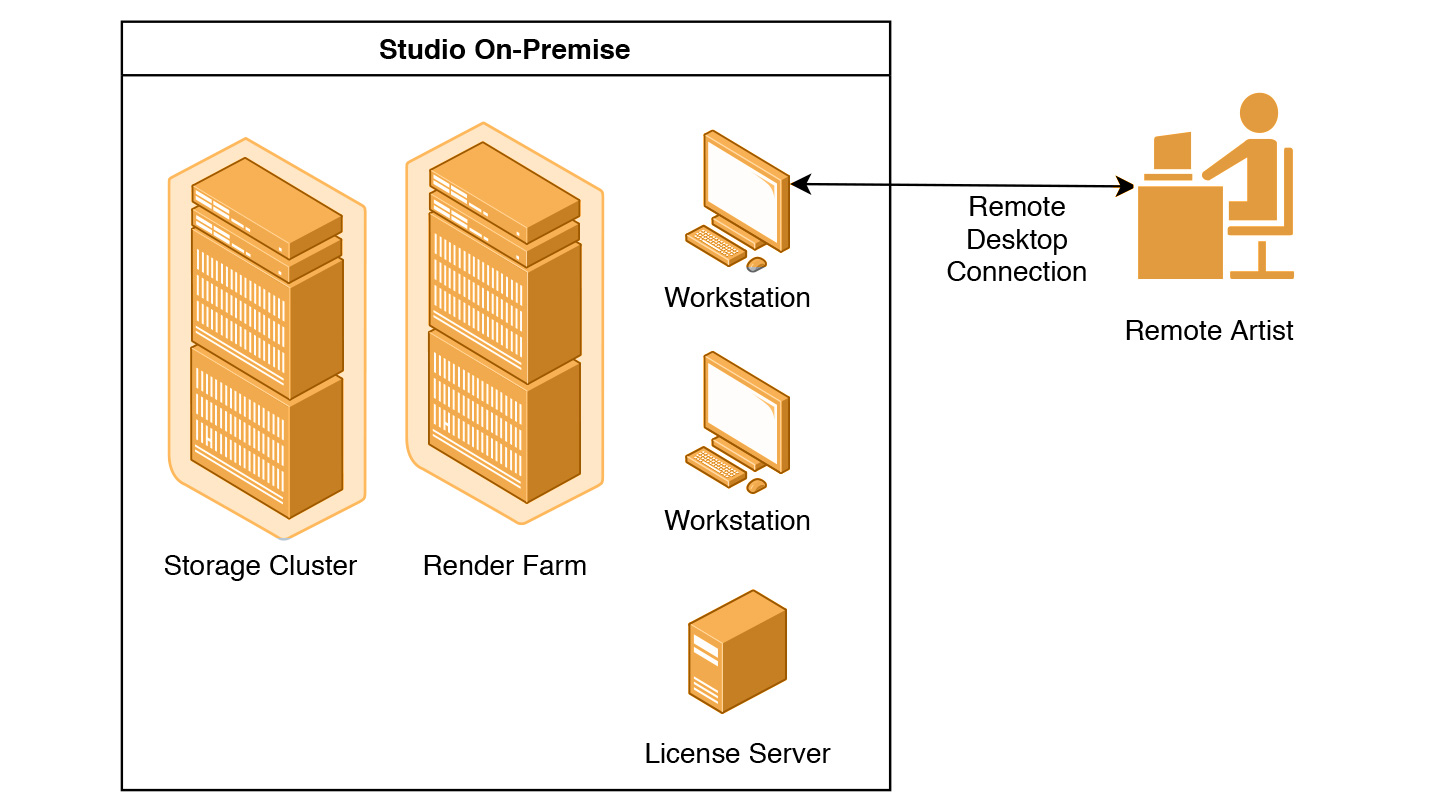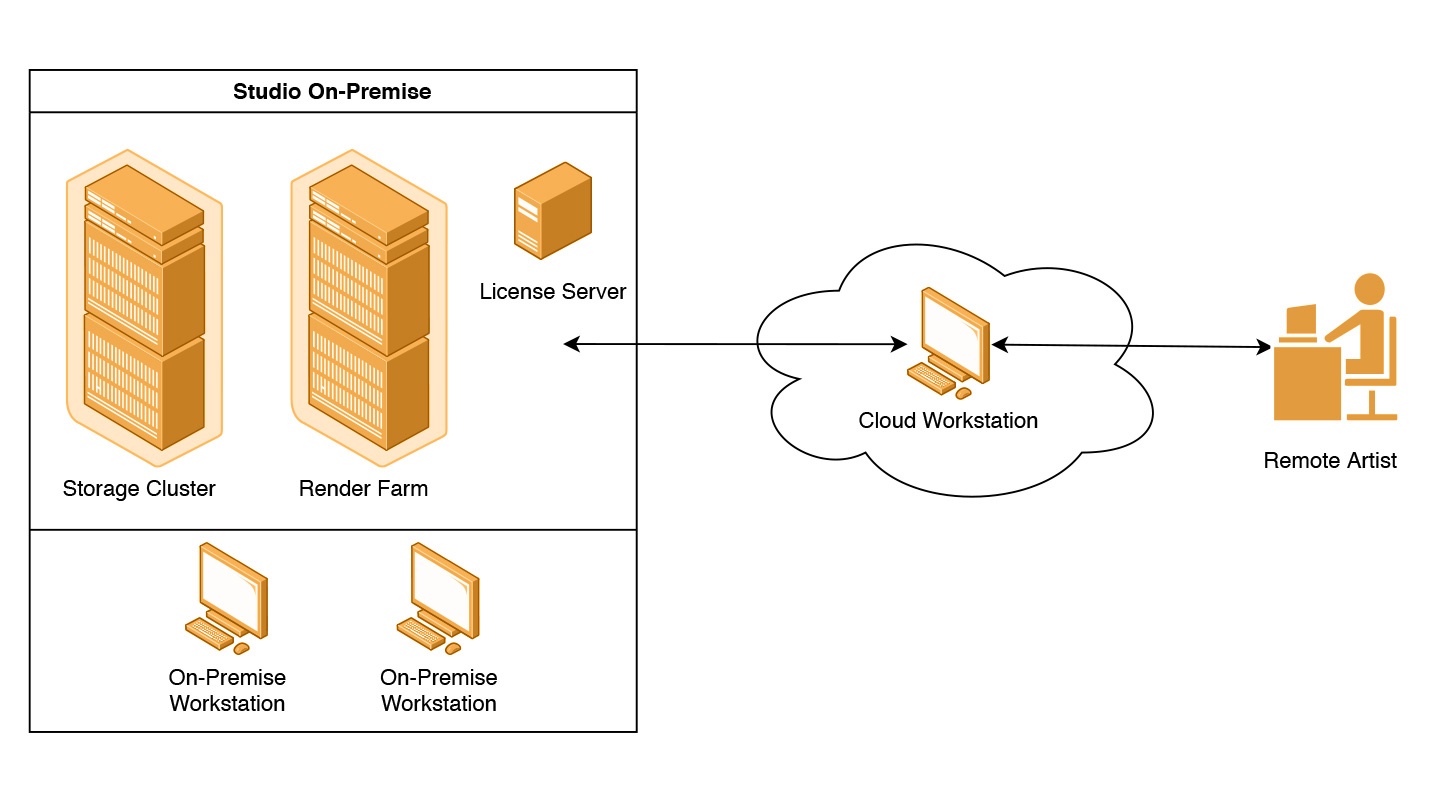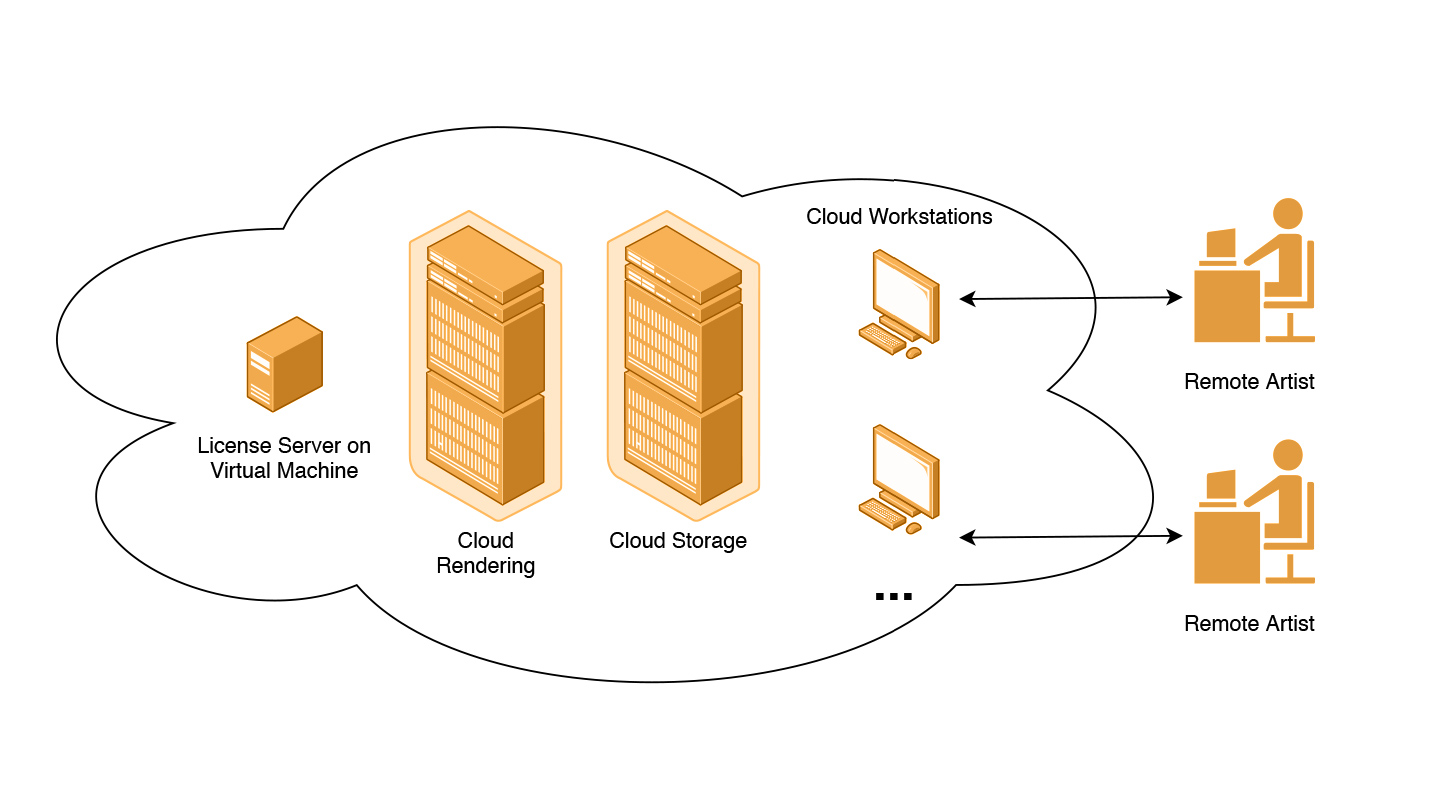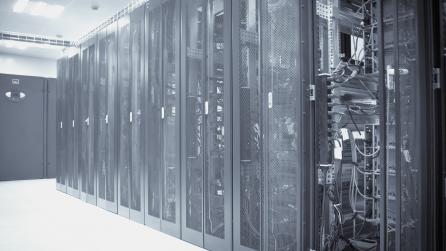Working Remotely with Foundry Tools
Working remotely is a rising industry trend further fuelled by the increasing power of cloud computing. More immediately, the restrictions put in place by coronavirus have led many studios to seek out the capability for artists to work remotely. What are your options for implementing a remote working solution using Foundry software, and what considerations do you need to take into account? This article is designed to help you navigate these critical questions.
Three ways to enable remote studio work
There are three common configurations for enabling remote studio work: connecting remote artists to existing on-premise workstations (“On-Premise”), providing virtual workstations in the cloud that are connected to on-premise infrastructure (“Hybrid”), and virtualizing all of the infrastructure into the cloud (“Pure Cloud”). Which of these options is best suited to your situation depends on several factors, including:
- The current configuration of your studio’s infrastructure
- The level of your studio's in-house technical expertise with cloud
- Requirements around cost, performance, and security
- The amount of time and resources at your disposal to adapt your pipeline
These factors are different depending on each studio’s specific situation. This article outlines the main configurations for remote working environments. This will allow you to dive deeper into the details while having a helpful high-level model to work against.
On-Premise

Remote work using On-Premise infrastructure involves having a secure and high-performance virtual desktop connection that links remote artists to workstations which are physically on the premises of the studio. Software licensing, access to data, and access to the render farm are automatic, since these are already set up within the studio. Artists are just streaming pixels from on-premise workstations to the comfort of their home. In this scenario, security and performance should be the major considerations. The advantage of an On-Premise remote work setup is that it’s relatively quick to get started and doesn’t require use of the cloud. The disadvantage is that it is inelastic, meaning you can only provide the resources that you already have, and performance will be limited based on the distance between your remote artists and your studio’s physical location.
Several commercial solutions exist for providing fast and secure remote desktop connections. Some popular examples include PCoIP from Teradici and RGS from HP, but there are many others on the market. Foundry recommends that you independently evaluate which option will work best for your specific use case by working with individual vendors.
Hybrid Cloud

Providing virtualized workstations to remote artists is an increasingly popular option. In this situation, artist workstations are spun up and down on-demand in the cloud, and are connected to your on-premise resources like license servers, storage, and render nodes. This option is often suitable for situations where your workstation needs are variable (either in terms of quantity or individual performance) but you wish to keep your studio’s core infrastructure like storage and licenses within physical confines. Because public cloud providers have excellent geographical coverage, you can benefit from spinning up virtual workstations closer to your remote artists to maximize performance.
You can set up a Hybrid Cloud by rolling your own solution with a public cloud provider like AWS, Azure, or Google Cloud Platform. For example, Foundry’s remote employees make use of Amazon Workspaces. However, without the appropriate IT expertise, setting up a hybrid cloud pipeline can be complicated: balancing security, cost, and performance is tricky and you will want to consider the overhead of maintaining the system’s uptime, especially during production crunch.
Another solution for Hybrid Cloud is to use an Infrastructure as a Service (IaaS) provider, like BeBop Technology. In this case your vendor takes care of provisioning workstations in the cloud and connecting them to your on-premise storage system and license server.
Hybrid Cloud is a good choice for studios that want to work with remote artists that are very distant, while also maintaining a strong physical presence for their studio. The main challenge with Hybrid Cloud is moving data back and forth between cloud workstations and your studio’s on-premise storage. While cloud workstations can be provisioned nearby to the artists using them, you will need to carefully consider how to move any required data into and out of your on-premise storage to these cloud workstations.
Pure Cloud

Pure Cloud is when all (or most) of your infrastructure is provisioned in the cloud, including workstations, storage, license servers, and render nodes. Pure Cloud has the benefit that your studio doesn’t need a central physical location, and doesn’t require expensive capital equipment like servers or workstations. With Pure Cloud, all of your IT infrastructure is provisioned elastically: you can turn everything off between projects, and scale everything up as projects ramp up.
Projecting costs in a Pure Cloud scenario is very different than the status quo. Costs scale according to utilization, so you will need to track the minute-to-minute usage of your cloud resources vs. up-front cost and depreciation like in a traditional model. You will also need to have knowledge of how to manage security in the cloud, which is different than traditional physical security in an on-premise environment.
The promise of Pure Cloud is that costs and performance are exactly matched to what you need—no more, no less. This provides the agility to scale up in short spikes when things are hot, and the resilience to scale costs down when you need to stay lean. One of the major considerations for whether to go Pure Cloud is your existing level of infrastructure: how much physical “stuff” (storage systems, servers, workstations) can you migrate to the cloud, and over what timeframe? If you’re starting out fresh, then maybe a Pure Cloud pipeline is a strong option to consider.
Implementing a Pure Cloud pipeline yourself can be quite challenging without the required cloud development expertise. While it is possible to roll your own Pure Cloud pipeline on AWS, Azure, or Google Cloud Platform, you might want to consider a ready-made commercial service. Examples of these include BeBop Technologies, StratusCore, and many others. You should independently evaluate which option will work best for your specific situation.
Licensing in the Cloud
There are some important licensing considerations when making the move to the cloud. Firstly, because workstations in the cloud are virtual, it’s impractical to make use of node-locked licensing. This is because node-locked licenses are tied to the physical properties of the machine, and in the case of virtual machines these properties can change each time a virtual machine is spun up for use. Floating licenses should be used instead, because floating licenses are only tied to the physical properties of the license server which manages allocation of licenses to each user. Using floating licenses requires establishing a connection between the license server and the virtual workstations being spun up. Be sure that this connection is secure, and compliant with Foundry’s licensing restrictions on regional use. If you’re not sure, then don’t hesitate to reach out to our support team.
If you’re planning to virtualize your license server (instead of using your on-premise one), then you will need to ensure that it is a static machine with a fixed System ID. If you’re using a managed infrastructure provider, then the license server is often provided out-of-the-box for you.
Note that floating licenses can only be installed on a single server. The important implication of this is that you cannot easily move your license server in and out of the cloud. While artist workstations that pull licenses can either be cloud-based or not, the license server itself must be fixed to a single machine and your licenses must be installed only on that single server. If you need to migrate an existing license server to another machine, for example by moving it from your on-premise studio into the cloud, then you will need to effect a license transfer request. You can also request to have a license transferred temporarily. License transfers are subject to some conditions, and Foundry is here to help you with this. Please don’t hesitate to reach out to your Foundry sales contact or to our support team for any questions you might have about permanent or temporary license transfers.
If your license server is running in the cloud then you will need a special “VM Enable” license installed on it. The VM Enable license is like a key that unlocks the capability for the license server to run on underlying hardware that is virtualized. Note that you only need the special VM Enable license on the license server itself, and only if it is a VM. Artists can always check out licenses regardless of whether their own individual workstation is virtualized or not. Please refer to our Support Portal for information about how to request and install a VM Enable license onto a cloud-based license server.
Summing Up
Remote work is something that our industry is warming up to more and more, especially as cloud technology is quickly increasing in capability. With threats like coronavirus making it unsafe to get everyone into a single physical location, it makes sense to think about how virtualization and cloud can help to reduce any impact. Longer-term, reaping the benefits of remote artists is increasingly within reach and worthy of consideration. We’ve discussed three models for achieving this:
- On-Prem: Linking remote artists to your existing on-prem resources with virtual desktops
- Hybrid Cloud: Workstations in the cloud linked to your existing studio’s on-premise resources
- Pure Cloud: Provision everything in the cloud—workstations, render nodes, storage, and licenses
Each model has important trade-offs that depend on your unique situation. Foundry is here to help you to navigate your journey to enabling remote workflows, so don’t hesitate to reach out to us!


